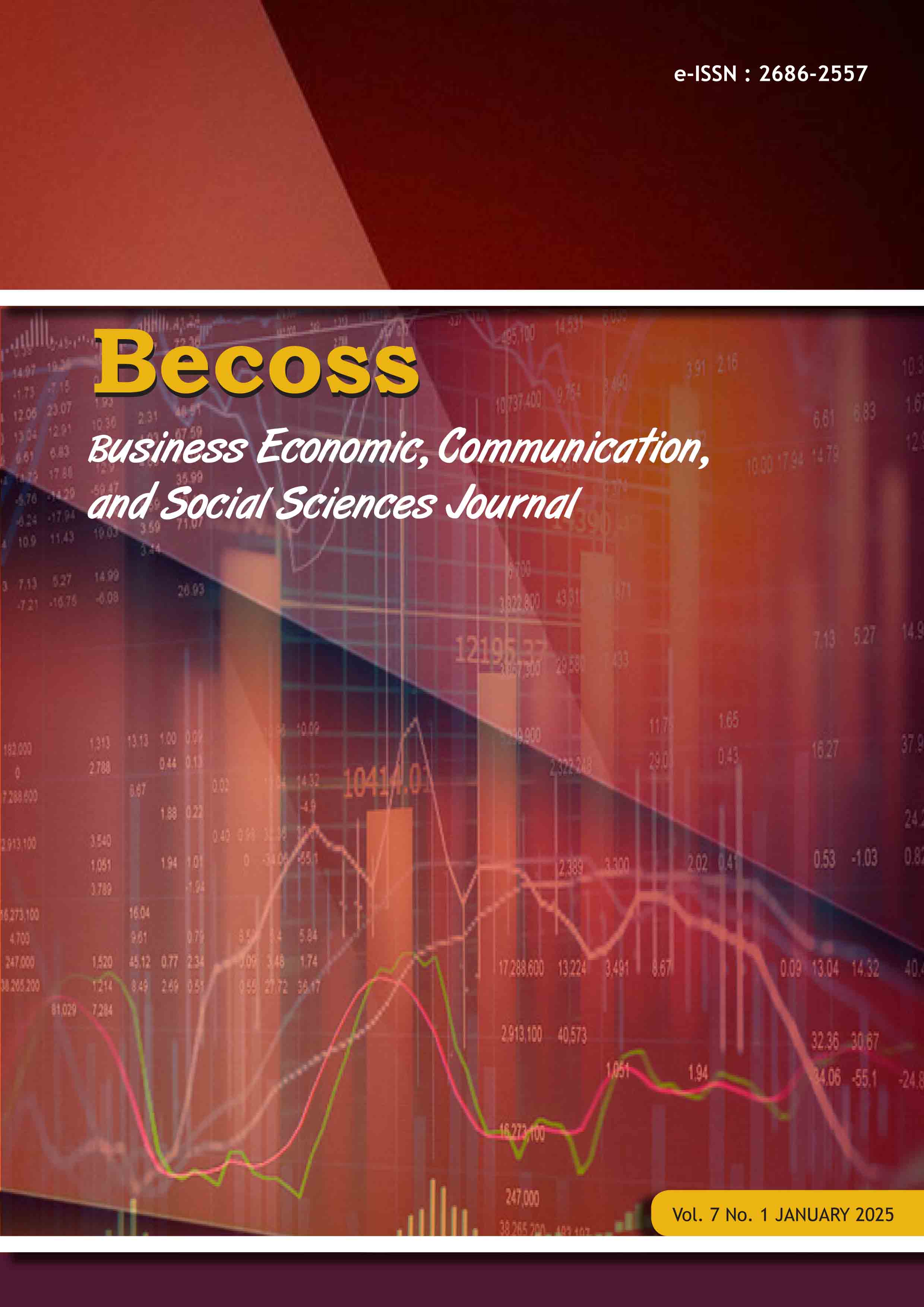Museum Experience and Reasoning about Evolution: A Case Study of Educated Indonesians
DOI:
https://doi.org/10.21512/becossjournal.v7i1.12104Keywords:
education, informal science learning, museum, evolution, adult literacyAbstract
This qualitative case study investigates the impact of informal learning experiences at a natural history museum on individuals' reasoning about evolution. Four Indonesian participants, aged 25-30, were interviewed about their understanding of evolutionary concepts after engaging in free-choice museum visits, while two did not visit the museum. Interviews were analyzed using a coding scheme to identify three reasoning patterns: Informed Naturalistic Reasoning (INR), Novice Naturalistic Reasoning (NNR), and Creationist Reasoning (CR). Findings reveal that museum-goers predominantly employed INR, demonstrating a clearer understanding of evolutionary concepts through gene mutation and inheritance, while non-museum-goers frequently used NNR and CR, reflecting intuitive and religious perspectives. The study highlights the museum's role in facilitating scientific understanding and suggests that informal learning environments can effectively complement formal education in fostering scientific literacy.
References
Barnes, R.M., Church, R.A. & Draznin-Nagy, S. (2017). The Nature of the Arguments for Creationism, Intelligent Design, and Evolution. Science & Education, 26, 27–47. https://doi.org/10.1007/s11191-017-9875-5
Bell, P., Lewenstein, B., Shouse, A. W., & Feder, M. A. (2009). Learning Science in Informal Environments: People, Places, and Pursuits. National Academies Press. https://doi.org/10.17226/12190.
Evans, E., Spiegel, A., Gram, W., Frazier, B., Tare, M., Thompson, S., & Diamond, J. (2009). A Conceptual Guide to Natural History Museum Visitors’ Understanding of Evolution. Journal of Research in Science Teaching, 47, 326-353. https://doi.org/10.1002/TEA.20337.
Friedman, W. E. (2020). Darwin in the garden: Engaging the public about evolution with museum collections of living objects. Plants, People, Planet, 2, 294–301. https://doi.org/10.1002/ppp3.10106
Gresch, H. (2020). Teleological explanations in evolution classes: video-based analyses of teaching and learning processes across a seventh-grade teaching unit. Evolution: Education and Outreach, 13. https://doi.org/10.1186/s12052-020-00125-9.
Groß, J., Kremer, K., & Arnold, J. (2019). Evolution Learning and Creationism: Thinking in Informal Learning Environments. Evolution Education Re-considered. pp. 285-305. https://doi.org/10.1007/978-3-030-14698-6_16.
Guilfoyle, L., & Erduran, S. (2021). Recalibrating the evolution versus creationism debate for student learning: towards students’ evaluation of evidence in an argumentation task. International Journal of Science Education, 43(18), 2974-2995.
Hanisch, S., & Eirdosh, D. (2023). Teaching for the Interdisciplinary Understanding of Evolutionary Concepts. In: du Crest, A., Valković, M., Ariew, A., Desmond, H., Huneman, P., Reydon, T.A.C. (eds) Evolutionary Thinking Across Disciplines. Synthese Library, vol 478. Springer, Cham. https://doi.org/10.1007/978-3-031-33358-3_8
Hartelt, T., Martens, H., & Minkley, N. (2022). Teachers' ability to diagnose and deal with alternative student conceptions of evolution. Science Education, 106, 706–738. https://doi.org/10.1002/sce.21705
Hohenstein, J., & Tenenbaum, H. R. (2023). Family conversations about species change as support for children's developing understandings of evolution. Science Education, 107, 810–834. https://doi.org/10.1002/sce.21783
Lelliott, A. (2016). Visitors’ views of human origins after visiting the Cradle of Humankind World Heritage Site. South African Journal of Science, 112(1/2). https://doi.org/10.17159/sajs.2016/20150210
Massarani, L., Nepote, A. C., Beck, J., & Scalfi, G. (2022). Conversations About Evolution During Family Visits to an Exhibition About Darwin in a Mexican Museum: An Analysis of Scientific Reasoning. Interdisciplinary Journal of Environmental and Science Education, 18(2), e2267. https://doi.org/10.21601/ijese/11520
Nesimyan–Agadi, D., & Assaraf, O. B. Z. (2022). Figuring out what works: learning and engaging with ideas about evolution within integrated informal learning environments. Instructional Science, 50, 391–424. https://doi.org/10.1007/s11251-021-09576-z
Newall, E., & Reiss, M. J. (2023). Evolution hesitancy: challenges and a way forward for teachers and teacher educators. Evolution: Education and Outreach, 16(5). https://doi.org/10.1186/s12052-023-00183-9
Parraguez, C., Núñez, P., Krüger, D., & Cofré, H. (2021). Describing changes in student thinking about evolution in response to instruction: the case of a group of Chilean ninth-grade students. Journal of Biological Education, 57(5), 1022–1038. https://doi.org/10.1080/00219266.2021.2009006
Pennock, R. (2003). Creationism and intelligent design. Annual review of genomics and human genetics, 4, 143-163. https://doi.org/10.1146/ANNUREV.GENOM.4.070802.110400.
Pew Research Center. (2012). The Global Religious Landscape: A Report on the Size and Distribution of the World's Major Religious Groups as of 2010. Pew Research Center. Retrieved from https://assets.pewresearch.org/wp-content/uploads/sites/11/2014/01/global-religion-full.pdf
Pickering, J., Fawcett, L., & Munstermann, L. (2012). An Alternative Approach: Teaching Evolution in a Natural History Museum Through the Topic of Vector-Borne Disease. Evolution: Education and Outreach, 5, 62-67. https://doi.org/10.1007/s12052-012-0398-x.
Scheuch, M., Scheibstock, J., Amon, H., Fuchs, G., Heidinger, C. (2021). Learning Evolution – A Longterm Case-Study with a Focus on Variation and Change. In: Levrini, O., Tasquier, G., Amin, T.G., Branchetti, L., Levin, M. (eds) Engaging with Contemporary Challenges through Science Education Research. Contributions from Science Education Research, vol 9. Springer, Cham. https://doi.org/10.1007/978-3-030-74490-8_10
Shtulman, A., & Schulz, L. (2008). The Relation Between Essentialist Beliefs and Evolutionary Reasoning. Cognitive science, 32 (6), 1049-62. https://doi.org/10.1080/03640210801897864.
Tenenbaum, H. R., To, C., Wormald, D., & Pegram, E. (2015). Changes and stability in reasoning after a field trip to a natural history museum. Science Education, 99(6), 1073-1091. https://doi.org/10.1002/sce.21184
To, C., Tenenbaum, H. R., & Hogh, H. (2017). Secondary school students’ reasoning about evolution. Journal of Research in Science Teaching, 54(2), 247-273. http://dx.doi.org/10.1002/tea.21347
Downloads
Published
How to Cite
Issue
Section
License
Copyright (c) 2025 Wahyu Setioko

This work is licensed under a Creative Commons Attribution-ShareAlike 4.0 International License.
Authors who publish with this journal agree to the following terms:
- Authors retain copyright and grant the journal right of first publication with the work simultaneously licensed under a Creative Commons Attribution License - Share Alike that allows others to share the work with an acknowledgment of the work's authorship and initial publication in this journal.
- Authors are able to enter into separate, additional contractual arrangements for the non-exclusive distribution of the journal's published version of the work (e.g., post it to an institutional repository or publish it in a book), with an acknowledgment of its initial publication in this journal.
- Authors are permitted and encouraged to post their work online (e.g., in institutional repositories or on their website) prior to and during the submission process, as it can lead to productive exchanges, as well as earlier and greater citation of published work.
USER RIGHTS
All articles published Open Access will be immediately and permanently free for everyone to read and download. We are continuously working with our author communities to select the best choice of license options, currently being defined for this journal as follows: Creative Commons Attribution-Share Alike (CC BY-SA)






